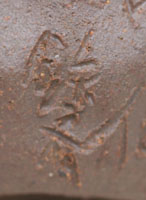Nanga
Sencha tea set: teapot - kyûsu, water cooler - yuzamashi and 5 tea cups - yunomi: “Sake nakasen”Signed: Tessai
Seals:
Technique: dark brown Kyôyaki with white slib on the inside and incised decorations on the outside pot Ø 9 x (12 x 11,2) x 8,7 cooler 7 x 8 x 4 kom Ø 6 x 4,3
Condition: fine
The inscription reads: “Shuchûsen” - Immortal(s) in the wine
From Du Fu: Yin zong ba xian ge Song on the eight immortals (Li Bai etc.) as they were drinking.
天子呼来不上船,自称臣是酒中仙。
The son of heaven calls them to himself but they do not board,
themselves they say I'm an immortal in the wine. (HK)Tessai was born in Kyoto into a family selling robes and accessories for the Buddhist clergy. As a result of a childhood illness he became partly deaf. It was therefore considered improbable that he would ever become a successful shopkeeper. Instead he went to study the Japanese classics in order to become a Shinto priest. He also did Chinese studies, specializing in the teachings of the neo-confucianist Wang Yang-Ming. Later he would study Buddhism, literature and Shingaku, a semi-religious system for self-cultivation.
As a youth Tessai met Ōtagaki Rengetsu (1791-1875) and became her special protégé. She taught him waka and encouraged his artistic inclinations. Tessai was mainly self-taught, indepently studying Nanga painting and learning from friends. He was, however, strongly influenced by Shinten’ô.
In the final years of the Tokugawa era Tessai was involved in the pro-imperialist movement. For fear of being arrested he left Kyoto in 1861 and travelled to Nagasaki. It was the first of many trips; Tessai became and avid traveller. In 1882 he settled in Kyoto where he spent the rest of his life. Although he worked as a priest at several Shinto shrines, he saw painting as his chief occupation. Between 1894 and 1904 he was a teacher at the Kyoto Prefectural Art School and he was a regular contributor to exhibitions of the Nanga Society. In 1917 he was appointed Artist to the Imperial Household and towards the end of his life he received an honorary court-rank. Tessai is often seen as the last great exponent of the Nanga school. (AB)
Reference:
Kanazawa
Aichi arts Center 1996
Kato 1998
Morioka & Berry ‘99 pp. 116-121 (# 20-21)
Morioka & Berry ‘08 p. 305-06 (# 11, 46)
Roberts p. 181
Araki pp. 2754-2755
Aburai pp. 266-267
Price: ON REQUEST

